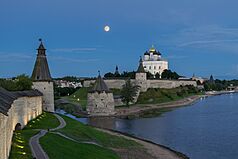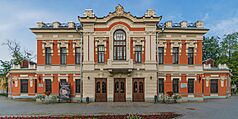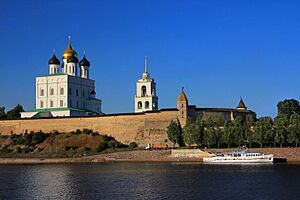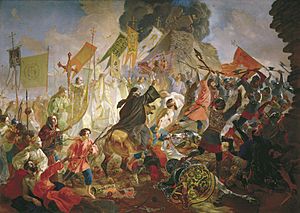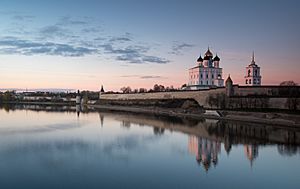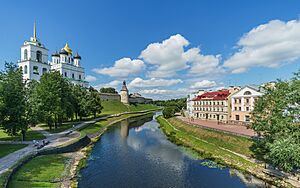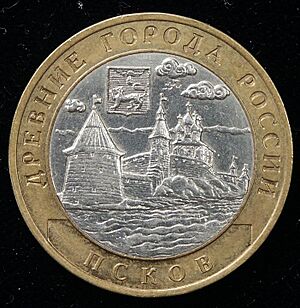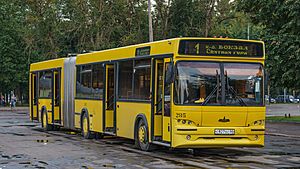Pskov facts for kids
Quick facts for kids Pskov (English)Псков (Russian) |
|
|---|---|
| - City - | |
| [[File:
From the top to bottom-right, Pskov Kremlin, Golden Quay, Church of Saint Basil of Caesarea, Pskov Academic Drama Theatre
|
|
|
|
|
| City Day | July 23 |
| Administrative status | |
| Country | Russia |
| Federal subject | Pskov Oblast |
| Administratively subordinated to | City of Pskov |
| Municipal status | |
| Urban okrug | Pskov Urban Okrug |
| Head | Boris Yolkin |
| Representative body | City Duma |
| Statistics | |
| Population (2010 Census, preliminary) |
203,279 inhabitants |
| - Rank in 2010 | 91st |
| Time zone | MSK (UTC+04:00) |
| First mentioned | 903 |
| Postal code(s) | 180xxx |
| Dialing code(s) | +7 8112 |
| Official website: http://www.pskovgorod.ru/ | |
Pskov (Russian: Псков) is an old and important city in northwestern Russia. It is the main city of Pskov Oblast. Pskov is located about 20 kilometers (12 miles) east of the Estonian border. It sits on the Velikaya River. In 2021, about 193,082 people lived there.
Pskov is one of Russia's oldest cities. In the Middle Ages, it was the capital of the Pskov Republic. It was also a busy trading spot for the Hanseatic League. Later, it became part of the Grand Duchy of Moscow. Pskov was an important border fortress for the Tsardom of Russia.
Contents
History of Pskov
Early Beginnings
Pskov is a very old city in Russia. Its original name was Pleskov. This name might mean "town of purling waters." The city was first mentioned in the year 903. This record tells us that Igor of Kiev married a local woman named Olga. She later became Saint Olga of Kiev.
People in Pskov often see 903 as the year the city was founded. In 2003, they celebrated Pskov's 1,100th anniversary. The first prince of Pskov was Sudislav, the youngest son of Vladimir the Great.
In the 12th and 13th centuries, Pskov was linked to the Novgorod Republic. In 1241, the Teutonic Knights took over the city. But Alexander Nevsky quickly recaptured it a few months later. This event was shown in the 1938 movie Alexander Nevsky.
To stay independent from the knights, Pskov chose a Lithuanian prince named Daumantas as their military leader in 1266. He became Orthodox and was known as Dovmont. Dovmont made the town stronger. He defeated the Teutonic Knights and took over parts of Estonia. His remains and sword are still in the local kremlin. The main part of the fortress he built is called "Dovmont's town."
In 1341, the city was under the Grand Duchy of Lithuania. In 1347, it joined the Novgorod Republic. The next year, it became the capital of the new and independent Pskov Republic.
The Pskov Republic Era
By the 14th century, Pskov was the capital of its own republic. The most powerful people were merchants. They traded with the Hanseatic League, a group of trading cities. Novgorod officially recognized Pskov's independence in 1348.
A few years later, the city council (called the veche) created a law code. This was known as the Pskov Judicial Charter. It was an important source for later Russian laws. German merchants were present in Pskov as early as the 13th century. The Hanseatic League also had a trading post there. Trade continued until the 17th century.
Pskov was often attacked because of its importance. The Pskov Krom (or Kremlin) survived 26 sieges in the 15th century alone. At one time, five stone walls surrounded the city. This made it almost impossible to capture. Pskov was also known for its unique style of icon-painting. Local builders were considered the best in Russia. Many special features of Russian architecture first appeared in Pskov.
Joining the Grand Duchy of Moscow
In 1510, Pskov became part of the Grand Duchy of Moscow. About 300 families were moved from Pskov to central Russia. New families of merchants and soldiers from Moscow settled in Pskov. At this time, Pskov had over 6,500 households. Its population was more than 30,000 people. It was one of the three biggest cities in Moscow's lands, along with Moscow and Novgorod.
Pskov in the Tsardom of Russia
The story of noble families being moved from Pskov in 1570 is part of Nikolai Rimsky-Korsakov's opera Pskovityanka. Pskov continued to face attacks. It survived a long siege by a large Polish-Lithuanian army. This happened during the final part of the Livonian War (1581–1582).
The Polish king, Stephen Báthory, tried to storm the city 31 times. Pskov was defended mostly by its citizens. Even when one wall was broken, the people managed to fix it and fight back. Báthory's secretary wrote that Pskov was "a big city, it is like Paris."
The population of the Pskov region dropped greatly in the mid-16th century. This was due to famines, diseases, and wars. The city also survived a siege by the Swedish army in 1615. Pskov's successful defense led to peace talks and the Treaty of Stolbovo.
Pskov in the Russian Empire
In the early 18th century, Peter the Great conquered Estonia and Livonia. This changed Pskov's role. It was no longer a key border fortress. The city's importance and wealth declined a lot. However, it became the center of its own Pskov Governorate in 1777.
During World War I, Pskov was the headquarters for Russia's Northern Front army. On March 15, 1917, Tsar Nicholas II gave up his throne here. This happened on the Imperial train. After peace talks with Germany, the Imperial German Army invaded the area.
The Estonian army also occupied Pskov for a few months in 1919. This was during the Estonian War of Independence.
Recent Times
Under the Soviet government, large parts of Pskov were rebuilt. Many old buildings, especially churches, were torn down for new construction. During World War II, Pskov suffered a lot. The German army occupied it from July 1941 to July 1944. The old fortress walls did not protect against modern weapons.
Thousands of people died during the war. Pskov has worked hard to become an important industrial and cultural center again.
City Administration
Pskov is the main administrative center of the Pskov Oblast. It is also the administrative center of Pskovsky District. However, Pskov itself is not part of that district. It is a separate administrative unit called the City of Pskov. For local government, it is known as Pskov Urban Okrug.
Landmarks and Sights
Pskov still has many parts of its medieval walls. These walls were built starting in the 13th century. The city's medieval fortress is called the Krom or the Kremlin. Inside its walls is the Trinity Cathedral. It is 256 feet (78 meters) tall. The cathedral was first built in 1138 and rebuilt in the 1690s. It holds the tombs of saint princes Vsevolod and Dovmont.
Other old cathedrals are at the Mirozhsky Monastery. This monastery was finished by 1152. It is famous for its 12th-century frescoes (wall paintings). There is also St. John's (finished by 1243) and the Snetogorsky monastery (built in 1310).
Pskov has many small, charming churches. Most of them are from the 15th and 16th centuries. Some notable ones include St. Basil's on the Hill (1413) and St. George's from the Downhill (1494). You can also see 17th-century houses of rich merchants. These include the Salt House and the Pogankin Palace.
Near Pskov, you can visit Izborsk. This was an important fortress in medieval Russia. The Pskov Monastery of the Caves is also nearby. It is Russia's oldest monastery that has been working without stopping since the mid-15th century. It attracts many visitors. Another place is Mikhaylovskoye. This was the family home of Alexander Pushkin, a famous Russian poet. He wrote some of his best works there. He is buried nearby.
On July 7, 2019, the Churches of the Pskov School of Architecture became a UNESCO World Heritage Site. This means they are very important and protected.
Geography and Environment
Pskov's Environment
Cars and trucks cause most of the air pollution in Pskov. Factories also release pollutants into the air. The Pskov Poultry Farm and Pskov Heating Networks are the biggest sources of air pollution from factories.
The rivers in Pskov Oblast, including those in Pskov city, have higher levels of certain metals. These include iron and copper. They also have organic compounds that are hard to break down.
The air quality in Pskov is generally considered low. The city is working to improve its drinking water. They plan to stop taking water from the Velikaya River. Instead, they will use water from underground sources. However, underground water can make hot water pipes get clogged because it is "harder."
Pskov's Climate
Pskov has a humid continental climate. This means it has four distinct seasons. It is influenced by its closeness to the Baltic Sea. Winters are relatively mild for Russia but still long. Summers are warm. More rain falls in summer and fall than in winter and spring.
| Climate data for Pskov (1991-2020, extremes 1874–present) | |||||||||||||
|---|---|---|---|---|---|---|---|---|---|---|---|---|---|
| Month | Jan | Feb | Mar | Apr | May | Jun | Jul | Aug | Sep | Oct | Nov | Dec | Year |
| Record high °C (°F) | 9.8 (49.6) |
11.3 (52.3) |
19.3 (66.7) |
27.6 (81.7) |
32.0 (89.6) |
35.3 (95.5) |
35.7 (96.3) |
35.6 (96.1) |
30.3 (86.5) |
22.6 (72.7) |
14.1 (57.4) |
12.4 (54.3) |
35.6 (96.1) |
| Mean daily maximum °C (°F) | −2.3 (27.9) |
−1.8 (28.8) |
3.4 (38.1) |
11.7 (53.1) |
18.1 (64.6) |
21.7 (71.1) |
24.1 (75.4) |
22.5 (72.5) |
16.7 (62.1) |
9.2 (48.6) |
2.9 (37.2) |
−0.6 (30.9) |
10.5 (50.9) |
| Daily mean °C (°F) | −4.7 (23.5) |
−5.0 (23.0) |
−0.7 (30.7) |
6.3 (43.3) |
12.2 (54.0) |
16.2 (61.2) |
18.6 (65.5) |
16.9 (62.4) |
11.7 (53.1) |
5.8 (42.4) |
0.8 (33.4) |
−2.6 (27.3) |
6.3 (43.3) |
| Mean daily minimum °C (°F) | −7.4 (18.7) |
−8.2 (17.2) |
−4.5 (23.9) |
1.3 (34.3) |
6.3 (43.3) |
10.6 (51.1) |
13.1 (55.6) |
11.6 (52.9) |
7.3 (45.1) |
2.6 (36.7) |
−1.4 (29.5) |
−4.9 (23.2) |
2.2 (36.0) |
| Record low °C (°F) | −40.6 (−41.1) |
−37.6 (−35.7) |
−29.7 (−21.5) |
−20.9 (−5.6) |
−5.9 (21.4) |
−0.1 (31.8) |
2.7 (36.9) |
1.3 (34.3) |
−4.6 (23.7) |
−12.5 (9.5) |
−23.8 (−10.8) |
−40.3 (−40.5) |
−40.6 (−41.1) |
| Average precipitation mm (inches) | 48 (1.9) |
37 (1.5) |
36 (1.4) |
39 (1.5) |
58 (2.3) |
85 (3.3) |
71 (2.8) |
85 (3.3) |
63 (2.5) |
65 (2.6) |
55 (2.2) |
45 (1.8) |
687 (27.1) |
| Average rainy days | 9 | 7 | 9 | 12 | 15 | 18 | 16 | 16 | 17 | 18 | 14 | 10 | 161 |
| Average snowy days | 22 | 20 | 14 | 5 | 1 | 0.03 | 0 | 0 | 0.03 | 3 | 13 | 20 | 98 |
| Average relative humidity (%) | 87 | 84 | 80 | 70 | 67 | 72 | 74 | 78 | 83 | 86 | 88 | 89 | 80 |
| Mean monthly sunshine hours | 41 | 71 | 136 | 189 | 279 | 300 | 285 | 233 | 152 | 90 | 34 | 25 | 1,835 |
| Source 1: Pogoda.ru.net | |||||||||||||
| Source 2: NOAA (sun 1961–1990) | |||||||||||||
Economy and Transport
Pskov has some industries. One company, JSC "AVAR," makes electrical parts for cars, trucks, and tractors. These parts include relays, switches, and fuses. Pskov is also served by Pskov Airport. This airport is used for both civilian and military flights.
Famous People from Pskov
Many notable people have come from Pskov.
- Alexander Bastrykin (born 1953), a high-ranking legal official in Russia.
- Irina Podnosova (born 1953), the current Chief Justice of Russia.
- Valentin Chernykh (1935–2012), a well-known screenwriter.
- Oxana Fedorova (born 1977), who was Miss Russia 2001 and Miss Universe 2002.
- Veniamin Kaverin (1902–1989), a famous writer.
- Oleg Lavrentiev (1926–2011), a Soviet and Russian physicist.
- Mikhail Minin (1922–2008), the first soldier to raise the Soviet flag over the Reichstag building in Berlin during World War II.
- Yulia Peresild (born 1984), a popular stage and film actress.

- Ferdinand von Wrangel (1797–1870), a famous explorer and seaman.
- Vsevolod of Pskov, a prince who was later recognized as a saint by the Russian Orthodox Church.
Sports Figures
Pskov has also produced many talented athletes.
- Nina Cheremisina (born 1946), a former rower.
- Sergei Fedorov (born 1969), a famous hockey player.
- Konstantin Shabanov (born 1989), a track and field athlete.
Sister Cities
Pskov has sister city relationships with several cities around the world. These connections help promote cultural exchange and friendship.
In February 2023, Roanoke, United States, announced it was pausing its sister city link with Pskov. This decision was made because of the ongoing conflict in Ukraine.
See also
 In Spanish: Pskov para niños
In Spanish: Pskov para niños


